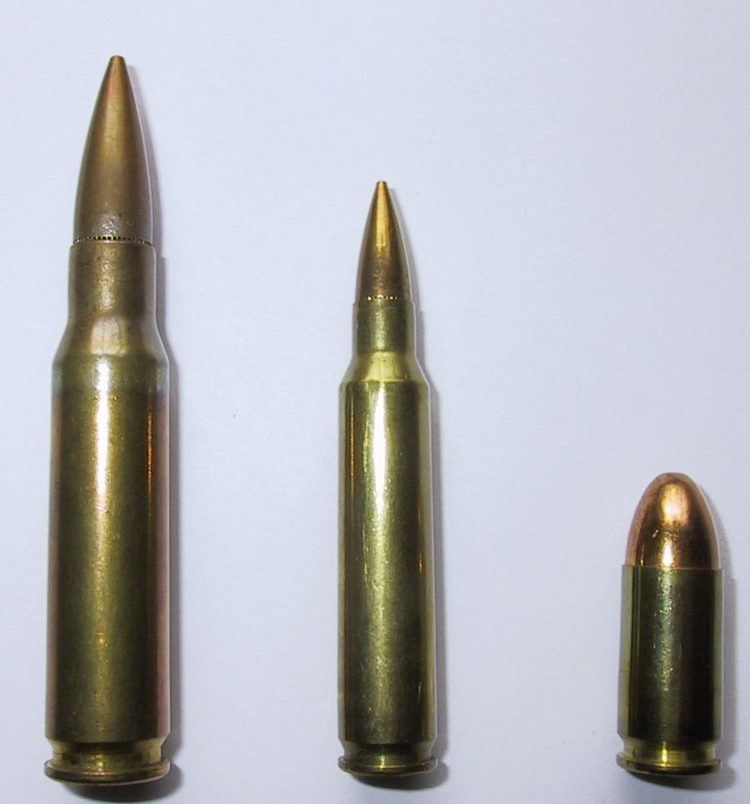 | ||
NATO EPVAT testing is one of the three recognized classes of procedures used in the world to control the safety and quality of firearms ammunition.
Beside this, there are also the Commission Internationale Permanente pour l'Epreuve des Armes à Feu Portatives (C.I.P.) class of procedures and the Sporting Arms and Ammunition Manufacturers' Institute (SAAMI) class of procedures.
EPVAT Testing is described in unclassified documents by NATO, more precisely by the AC/225 Army Armaments Group (NAAG).
EPVAT is an abbreviation for "Electronic Pressure Velocity and Action Time". With Action Time the (short amount of) time required between the ignition of the primer and the projectile leaving the barrel is meant. This is a comprehensive procedure for testing ammunition using state-of-the-art instruments and computers. The procedure itself is described in NATO document AC/225 (Com. III/SC.1)D/200.
Unlike the C.I.P. procedures aiming only at the user's safety, the NATO procedures for ammunition testing also includes comprehensive functional quality testing in relation with the intended use. That is, not only the soldier's safety is looked at, but also his capacity to incapacitate the enemy. As a result, for every ammunition order by NATO, a complete acceptance approval on both safety and functionality is performed by both NATO and the relevant ammunition manufacturers in a contradictory fashion.
For this, a highly accurate and indisputable protocol has been defined by NATO experts using a system of reference cartridges.
The civilian organisations C.I.P. and SAAMI use less comprehensive test procedures than NATO, but NATO test centres have the advantage that only a few chamberings are in military use. The C.I.P. and SAAMI proof houses must be capable of testing hundreds of different chamberings requiring lots of different test barrels, etc..
Proofing
The minimum proof and performance requirements for small arms ammunition of NATO calibres are covered in STANAGs as follows:
Each weapon and component considered vulnerable to the effects of a rapid change in pressure, for example barrels, breech blocks and bolts, will be tested by firing one dry round at a corrected minimum of 25% over pressure and one oiled round at a corrected minimum of 25% over pressure. 25% over pressure means 25% in excess of the Service Pressure (Pmax). The Service Pressure is defined as the mean pressure generated by the Service Cartridge at a temperature of 21 °C (70 °F). Such a high pressure proof is conducted with both the weapon and ammunition conditioned to an ambient temperature of 21 °C (70 °F).
Each weapon will be individually tested, from an ammunition lot that produces a minimum corrected mean chamber pressure in accordance with the table below:
The above proof round pressure requirements for the 9 mm and 12.7 mm rounds established by the British Ministry of Defence are higher than the current (2008) C.I.P. proof round pressure requirement legislation for the civilian equivalent 9mm Parabellum (C.I.P. Pmax rating 235 MPA / (34,083 psi) and .50 Browning (C.I.P. Pmax rating 370 MPA / (53,663 psi) rounds. The 9×19mm NATO and 12.7×99mm NATO rounds can be regarded as overpressure ammunition
Unlike the civilian C.I.P. test procedures NATO EPVAT testing procedures for the "NATO chamberings" require the pressure sensor or transducer to be mounted ahead of the case mouth. The advantage of this mounting position is that there is no need to drill the cartridge case to mount the transducer. Drilling prior to firing is always a time consuming process (fast quality control and feedback to production is essential during the ammunition manufacturing process). The disadvantage of this mount is that the pressure rises much faster than in a drilled cartridge case. This causes high frequency oscillations of the pressure sensor (approx 200 kHz for a Kistler 6215 transducer) and this requires electronic filtering with the drawback that filtering also affects the lower harmonics where a peak is found causing a slight error in the measurement. This slight error is not always well mastered and this causes a lot of discussion about the filter order, cutoff frequency and its type (Bessel or Butterworth).
Due to NATO EPVAT using technically differing proof test standards than SAAMI and C.I.P., EVPAT pressures cannot be directly compared with SAAMI and C.I.P. pressures.
